Tara Chace Heads to
By Mark Wheaton
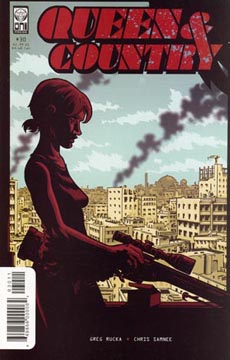 “What they have isn’t conclusive. You two will have to find a smoking gun that the CIA can present to the White House and the Pentagon after the fact, justifying the action.”
“What they have isn’t conclusive. You two will have to find a smoking gun that the CIA can present to the White House and the Pentagon after the fact, justifying the action.”
“Queen & Country” returns. Thank friggin’ God, right? What’s even better is that the first issue is great. Incredibly thinly veiled when remarking on current events, but great.
What if the American CIA had found out that the “George Washington of
How thinly veiled is it? The Ahmed Chalabi in this is named Ahmed Ibrahim Habib Allawi. Allawi is specifically described as the “George Washington of
And it’s fascinating.
As usual, the inter-play between Tara and Director of Operations Paul Crocker is top-shelf (as is Crocker’s bizarre dialogue with his ever-perky-by-force-of-will assistant, Kate), but the fact that Tara is still cracking while being paired with the new Minder 2, Nick Poole, means that this could go anywhere.
But what’s really great is that the first few pages make it seem like the issue of the assassination will be the sum total of the mission – will Tara’s team succeed at killing Allawi or not? But then, he’s dead by the end of #1 and the rest of the arc turns out to be about gathering the evidence the Pentagon needs in order to validate why they wanted him dead in the first place. As usual, writer Greg Rucka (and artist Chris Samnee) deliver a top-notch espionage thriller – backed by so much research that it goes way beyond typical airport-fiction or Hollywood fare – showing again why this is one of the best titles out there.
RATING: 
Ennis Takes Us Out With One Shot– The Punisher: The Tyger
by Jeb D.
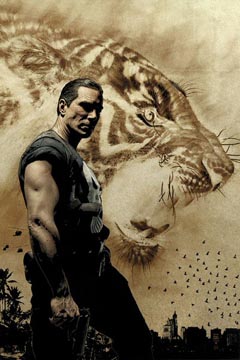 Re-invention of a comic character is one of the more interesting aspects of the long-running superhero. Daredevil, for instance, was a one-note variation on the urban superhero for many years, until Frank Miller got hold of him, and started looking at his origin and characterization in new ways, ultimately starting him on the road to the troubled vigilante that he is today. Other heroes have had origins rebooted, or found new powers or costumes to keep them fresh.
Re-invention of a comic character is one of the more interesting aspects of the long-running superhero. Daredevil, for instance, was a one-note variation on the urban superhero for many years, until Frank Miller got hold of him, and started looking at his origin and characterization in new ways, ultimately starting him on the road to the troubled vigilante that he is today. Other heroes have had origins rebooted, or found new powers or costumes to keep them fresh.
When writer Garth Ennis began writing The Punisher, though, he took the opposite approach: he embraced the fundamentals of the character, and instead of downplaying his
Last year, one of the best one-shot stories that either of the Big 2 published was Punisher: The Cell. This year, Ennis, working with legendary artist John Severin, brings us another trip into Frank Castle’s past with Punisher: The Tyger, and if it lacks the claustrophobic intensity of The Cell, it’s still a compelling mix of character and action.
It’s 1960, Frank Castle is ten. He’s fallen under the thrall of a local teenage girl who finds him a genial friend and confidant despite the age difference. She has an older brother, a Marine, whose tales of the Corps fascinate young Frank… and she’s got a secret. We also spend time with Frank’s parents, discover a most unexpected passion in the young boy, and meet the first of the organized crime figures that will drive the adult Frank’s hatred. Though Frank Castle is more an observer than an actor in this story, he’s a compelling narrator, and no one’s going to feel shortchanged by any lack of action. It’s brutal in Ennis’ particular fashion: the physical violence is always less horrifying than the emotional deformity that allows one human to practice it upon another.
As to veteran artist John Severin, an analogy: Edith Head was a film costume designer whose career spanned 50 years, and was still getting Oscar nods in her 80’s. Toward the end of that career, someone asked why she continued going so strong, and she replied that she was one of the few who still remembered how people used to dress in the days when she began. Severin’s art here is much like that: with all respect to terrific artists like Gene Ha or Michael Lark, even the most scrupulous research will always yield, in terms of effectiveness, to the actual memory of having lived in a time. And Severin makes every panel breathe with the feel of the past.
RATING: 
Tesla and Twain Fight Industrialists in Revisionist Caper The Five Fists of Science
By Mark Wheaton
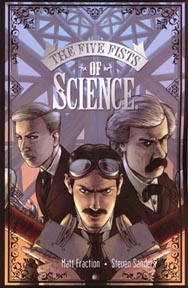 It is near impossible to read a comic adventure featuring a super team of turn-of-the-century luminaries fighting a supernatural battle against other turn-of-the-century luminaries without immediately thinking of Alan Moore’s “The League of Extraordinary Gentlemen,” the apotheosis of such endeavors. With that thought in mind, “The Five Fists of Science” will undoubtedly suffer under that comparison despite the fact that it is actually quite different and more akin to, say, the film “Sky Captain and the World of Tomorrow” or even the alternative timeline fiction of R.A. Salvatore than the Alan Moore-penned, obscurata-focused epic.
It is near impossible to read a comic adventure featuring a super team of turn-of-the-century luminaries fighting a supernatural battle against other turn-of-the-century luminaries without immediately thinking of Alan Moore’s “The League of Extraordinary Gentlemen,” the apotheosis of such endeavors. With that thought in mind, “The Five Fists of Science” will undoubtedly suffer under that comparison despite the fact that it is actually quite different and more akin to, say, the film “Sky Captain and the World of Tomorrow” or even the alternative timeline fiction of R.A. Salvatore than the Alan Moore-penned, obscurata-focused epic.
That said, it is not without its faults, but is still a merry, jaunty tale of an imagined team-up between the huckster-ish Mark Twain, the staunch Armistice supporter (the contemporary, Fox News-ready descriptor would be “appeasing surrender monkey”) Baroness Bertha von Suttner and the quite odd Nikola Tesla as they attempt to stop wars forever and make a barrel of cash off of one of Tesla’s inventions – a giant automaton that, if sold to all the warring nations of the world at once, would hopefully stop any future arms race before it even began.
Their opponents in this are led by financier J.P. Morgan, portrayed as a devoted dark spiritualist (a nod to Cornelius Vanderbilt, perhaps?), who employs a positively rancid Thomas Edison and foolish Guglielmo Marconi to harness science in a similar way, but for his own nefarious purposes.
Before you get your historical accuracy-panties in a bunch,
So,
So, with that set-up and well-drawn characters, the comic should be a slam-dunk and almost is, except for the somewhat twist-too-far Lovecraftian final act that pits a Cthulu-ed out Morgan against Tesla’s automaton/secret weapon. The tone shifts from a wild yarn about science conquering industry to something out of “B.P.R.D.” While both stories are fine in their own right, the marriage feels slightly awkward and threw me for a loop. One minute, it’s all hucksterism, science and show with a semi-grounded feel – then it’s the Apocalypse.
Beyond that, however, it’s a fun romp that makes a hero – albeit gleefully flawed – out of a latter-life Mark Twain, who characterization is equal times zany and thoughtful, brash and brilliant. Tesla, one of history’s more fascinating and brilliant lunatics, provides a noble counterpoint to Twain, so here’s hoping the pair embark on several more adventures.
RATING: 
![]()

Showcase Presents The Haunted Tank
(DC Comics)
by
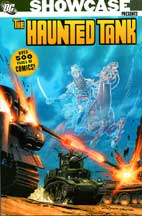 In that great book about
In that great book about
Either the creators of comics or the audience doesn’t understand this truth, as war comics, like westerns, have all but vanished from the market place. Those of either genre, when they do appear, take a viewpoint that so caters to the truly schizophrenic modern concepts of both subjects as to become unreadable. In the 1950s and early1960s this was not yet true. Among several quite good titles in DC’s stable was G.I. Combat. In issue #87, it introduced an ongoing series about a Stuart tank crew composed of Southern boys who played calvary games as youths together, and enlisted in that same branch of the army when World War II began. The leader of their games and the commander of their tank (named for that Confederate cavalry leader Jeb Stuart, as was the tank) at critical moments is visited by the spirit of Jeb Stuart, who imparts a cryptic pearl of wisdom that either reflects deeply on the situation or assists in saving the crew and defeating the enemy.
The stories have no historical accuracy. While no one shies away from the fact that people die in war, the gore remains discreet. There is a certain repetitiousness to the stories, but of course that is true of all comics that become an ongoing series. Despite these flaws, the stories are readable and entertaining. The true attraction of this book is the artwork of Russ Heath and Joe Kubert. Heath, whose work in Arizona Kid, Kid Colt Outlaw, Frontline Combat, Silent Knight, Brave and the Bold, Sea Devils, and Blazing Combat, was popular and amazingly realistic. His ability to draw the nuts and bolts of the scenery, weapons, and costumes is as good as any. Archie Goodwin once said that Heath’s work was "filled with convincing grit." Only too true. Kubert, who had been around an equally long time, came into his own with Tor, the Caveman strip, but is best remembered for his war comics, most notably Sgt. Rock and Enemy Ace. These two artists carry this title, and the quality and worth of their work here is made readily apparent when, in scattered stories, other artists step in for short stints.
Here we get 33 issues of G.I. Combat, with an additional one of Our Army At War, and one of the Brave And The Bold, all presented in chronological order. Its is printed in black and white on traditional newsprint at a very economical price. This Showcase series is a great ongoing production that gives everyone a chance to read a lot of material that would otherwise be priced far out of reach for most. Each and every one that is printed deserves the support of every fan.
RATING: 
Tales of Supernatural Law
(Exhibit A Press)
By Jeb D.
 It’s possible to speculate endlessly on what it would be like if fantastical creatures like zombies or vampires walked the earth. The one thing that’s beyond debate, though, is that (in the
It’s possible to speculate endlessly on what it would be like if fantastical creatures like zombies or vampires walked the earth. The one thing that’s beyond debate, though, is that (in the
And that’s where this witty series comes in. Tales of Supernatural Law began as “Wolff and Byrd, Counselors of the Macabre,” originally appearing as a comic strip in The Brooklyn Paper in the 1980’s. From there, it was picked up by the prestigious National Law Journal, running for 14 years. In the 90’s, writer/artist Batton Lash decided to try his characters in a more expanded format, and the comic series Tales of Supernatural Law was born.
In contrast to, say, Dan Slott’s She-Hulk (which looks at established superhero lore through the legal system), this series works from the legal system back out to the fantastic. I’m no lawyer, but the cases, no matter how outrageously horrific the protagonists, always feel well-grounded in law, and most of the laughs come from taking them seriously. Glamorous Alanna Wolf and her slightly schlubby partner Jeff Byrd find themselves involved in cases replete with swamp monsters, zombies, haunted houses, and Dracula himself. The continuing characters (notably Wolff and Byrd’s less-ditzy-than-she-seems secretary Mavis) are allowed to grow and develop without taking the focus off the wild tales at the center of the story.
Lash’s presentation is more than a bit reminiscent of the great comics of the 50’s: EC horror and the comic-book incarnation of “Mad;” no surprise, given that Lash actually studied art under the tutelage of instructors like Harvey Kurtzman and Will Eisner. And the guy’s brilliantly funny: in addition to Supernatural Law, he’s written Bongo’s Radioactive Man comics, as well as the hysterical Archie Meets Punisher crossover from a few years back. He mixes character-driven moments of humor with outrageous laughs on nearly every page, and can do a gross-out zombie with the best of them.
This first volume collects eight issues of the series, 180-plus pages of horror and hilarity for less than seventeen bucks. That’s a bargain, folks.
And, c’mon—how can you NOT buy a book from a guy with a name as cool as Batton Lash?
RATING: 
Zorro: The Complete Classic Adventures By Alex Toth
(Image Comics)
By
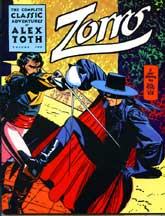
 Although Alex Toth did some superhero work in the 1940s on titles like Dr. Mid-night, Atom, and Green Lantern most fans have either never seen any of that work or are interested only as collectors who want everything he ever did. In the 1950s he worked as an assistant on Casey Ruggles, often cited as the best western strip newspapers ever carried. His most memorable comic book work came when he worked for Dell comics in the late 1950s doing versions of hit movies and television shows.
Although Alex Toth did some superhero work in the 1940s on titles like Dr. Mid-night, Atom, and Green Lantern most fans have either never seen any of that work or are interested only as collectors who want everything he ever did. In the 1950s he worked as an assistant on Casey Ruggles, often cited as the best western strip newspapers ever carried. His most memorable comic book work came when he worked for Dell comics in the late 1950s doing versions of hit movies and television shows.
Dell "sold" itself with the blurb "Dell comics are good comics." On a certain level this was true, but they were selling this while Marvel was reconstructing the superhero comic where most kids’ attention was attracted. Still, many discovered what a real artist could do because Toth’s work was at its best display there. Among the best of this work are the Zorro comics which retell that astoundingly popular television show. These two volumes reprint all of Toth’s work for that title minus the covers (photos of the title character from television) and without color, which is not missed as the work easily stands on its own. Chunky black blobs and lines just jump out and grab the viewer. The first thing anyone tries to learn in art school is line; its control and variations. No one ever learned those lessons better than Alex Toth. Not those scratchy or completely uniform lines that most of today’s comic artists use, but massive lines of power that diminish and grow again. These are the lines of a great artist that one finds in works in major museums, controlled yet appearing to be loose and accidental.
 The design and compositional work is equally outstanding. This is the work of a true master artist at his prime. The only critical remark that can be made is that there is not more work to be included. If there is any comic book artist whose work deserves to be collected in a first class manner by some publisher, it is Alex Toth. Many reading this probably don’t know the name as he did so little modern work in the superhero field. But they probably do know his design work in animation. He designed Space Angel, Space Ghost, Thunderbolts, Batman, and many others. Pros know his comic work extremely well. Gil Kane said, "Next to Eisner, Toth was the comic medium’s most important teacher." When he worked at Standard comics, the publisher’s art staff had only one rule, and that was to draw like Alex Toth. Murphy Anderson said Alex wasn’t appreciated by the general audience because his one fault was "… he got so wrapped up in design that he would forget to tell the story."
The design and compositional work is equally outstanding. This is the work of a true master artist at his prime. The only critical remark that can be made is that there is not more work to be included. If there is any comic book artist whose work deserves to be collected in a first class manner by some publisher, it is Alex Toth. Many reading this probably don’t know the name as he did so little modern work in the superhero field. But they probably do know his design work in animation. He designed Space Angel, Space Ghost, Thunderbolts, Batman, and many others. Pros know his comic work extremely well. Gil Kane said, "Next to Eisner, Toth was the comic medium’s most important teacher." When he worked at Standard comics, the publisher’s art staff had only one rule, and that was to draw like Alex Toth. Murphy Anderson said Alex wasn’t appreciated by the general audience because his one fault was "… he got so wrapped up in design that he would forget to tell the story."
You owe it to yourself to seek out these books. They are out of print but can still be located at Amazon. Perhaps someone will begin to reprint more of his work, and this is greatly to be hoped as we will see no more from the master. Last week he passed this life, appropriately enough, while at his drawing table. No greater pen and ink artist ever drew for the comics, and these books are some of his best work.
RATING: 
![]()

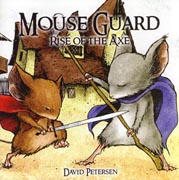 Mouse Guard: Rise of the Axe #3 (Archais Studios Press) – Mice with swords – what else do you need to know? Returning to the plotline of issue #1 (issue #2 featuring Mouse Guard Sadie embarking on an adventure of her own), Saxon, Kenzie and Lieam continue their search for the killer of the grain-cart merchant mouse seen in the opening of the series. In the small
Mouse Guard: Rise of the Axe #3 (Archais Studios Press) – Mice with swords – what else do you need to know? Returning to the plotline of issue #1 (issue #2 featuring Mouse Guard Sadie embarking on an adventure of her own), Saxon, Kenzie and Lieam continue their search for the killer of the grain-cart merchant mouse seen in the opening of the series. In the small
RATING: 
 Zombies #1 (IDW) – With so many zombie comics flooding the market these days, one more may seem like the straw that tumbled the camel over the tipping point, but then IDW’s new book “Zombies” shows just enough originality that, well hell, why not one more? We’re introduced to a group of prisoners on a chain gang being driven across a remote stretch of highway when someone in the road (could it be…a zombie?!?) sends them swerving into an accident. When the guards head off to investigate, the prisoners find out real fast that being chained together during a zombie apocalypse isn’t always the best way to go. Short and sweet, but with cool art and a brisk storytelling style, “Zombies” could make up for some of the recent weaker entries into the four-color universe of the undead. Here’s hoping. – Mark
Zombies #1 (IDW) – With so many zombie comics flooding the market these days, one more may seem like the straw that tumbled the camel over the tipping point, but then IDW’s new book “Zombies” shows just enough originality that, well hell, why not one more? We’re introduced to a group of prisoners on a chain gang being driven across a remote stretch of highway when someone in the road (could it be…a zombie?!?) sends them swerving into an accident. When the guards head off to investigate, the prisoners find out real fast that being chained together during a zombie apocalypse isn’t always the best way to go. Short and sweet, but with cool art and a brisk storytelling style, “Zombies” could make up for some of the recent weaker entries into the four-color universe of the undead. Here’s hoping. – Mark
RATING: 
 Ultimate Extinction #5 (Marvel). Writer Warren Ellis and artist Brandon Peterson provide a satisfying wrapup to the mega-galactic epic. The marshaling of forces from the Ultimate Universe allows for some exciting crosscutting between the various power centers (Xavier and Jean, Fury and SHIELD, the FF) and Cap and Iron Man leading the troops against the clone army. Ellis keeps the story fresh, but still manages to throw in nods to the original Galactus saga (and wait’ll you see the Ultimate “Ultimate Nullifier”), particularly in the thematic elements that Stan Lee carried over into the Silver Surfer’s own series. Brandon Peterson’s art has been the best of this entire trilogy, and he goes out in style, ranging from the big clone battle, to the quiet moments between Jean and Xavier, and Reed and Sue, to the spectacular final showdown with Gah Lak Tus. The annoying crosshatching in the inking/coloring process seems less intrusive this time. Ellis also gives us a final page that provokes chuckles, then chills, and really makes us hope that he’s not done with his involvement in the Ultimate Universe. –Jeb D.
Ultimate Extinction #5 (Marvel). Writer Warren Ellis and artist Brandon Peterson provide a satisfying wrapup to the mega-galactic epic. The marshaling of forces from the Ultimate Universe allows for some exciting crosscutting between the various power centers (Xavier and Jean, Fury and SHIELD, the FF) and Cap and Iron Man leading the troops against the clone army. Ellis keeps the story fresh, but still manages to throw in nods to the original Galactus saga (and wait’ll you see the Ultimate “Ultimate Nullifier”), particularly in the thematic elements that Stan Lee carried over into the Silver Surfer’s own series. Brandon Peterson’s art has been the best of this entire trilogy, and he goes out in style, ranging from the big clone battle, to the quiet moments between Jean and Xavier, and Reed and Sue, to the spectacular final showdown with Gah Lak Tus. The annoying crosshatching in the inking/coloring process seems less intrusive this time. Ellis also gives us a final page that provokes chuckles, then chills, and really makes us hope that he’s not done with his involvement in the Ultimate Universe. –Jeb D.
RATING: 
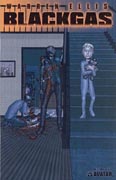 Black Gas #3 (Avatar) – Warren Ellis’s “Black Gas” concludes rather predictably, but then tags it with the announcement of “Black Gas 2” – a much more wide-ranging horror adventure – coming in September. Basically, Tyler and his somewhat annoying girlfriend fight their way off the island, but then
Black Gas #3 (Avatar) – Warren Ellis’s “Black Gas” concludes rather predictably, but then tags it with the announcement of “Black Gas 2” – a much more wide-ranging horror adventure – coming in September. Basically, Tyler and his somewhat annoying girlfriend fight their way off the island, but then
RATING: 
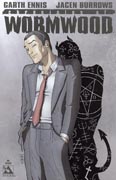 Chronicles of Wormwood #0 (Avatar) – In an odd bit of symmetry, a month after Ben Templesmith’s “Wormwood: Gentleman Corpse” comic comes out, Garth Ennis and Jacen Burrows preview their new Avatar title, “Chronicles of Wormwood,” a similarly devilishly-themed, darkly comedic book. But as both books’ #0 issues seem to indicate, the marketplace is big enough for both if they keep it going at the levels they’re starting from. Ennis’ “Wormwood” tells the story of a grown-up Son of Satan who happens to be best friends with Jesus (“Jay”) as both of them have turned their backs on their Fathers and are living as close to a normal life as possible on Earth. Jay is black with dreadlocks, Joan of Arc is the titular Danny Wormwood’s off-the-books masochistic sex slave, and Danny himself has a talking rabbit that starts off the book by laughing at his owner with the remark, “No pussy for you today, huh, Wormwood?” And then the last page features a gorgeous, single-panel shot of Wormwood’s Satan-with-horns-and-hooves father, an issue he’s been desperately keeping away from his current girlfriend. Yes, it’s a short, mere 99 cent preview, but “Chronicles of Wormwood” looks like it could be another truly memorable Ennis title that makes your every day problems seem small when compared to what is being shouldered by the Spawn of Darkness. Hilarious. – Mark
Chronicles of Wormwood #0 (Avatar) – In an odd bit of symmetry, a month after Ben Templesmith’s “Wormwood: Gentleman Corpse” comic comes out, Garth Ennis and Jacen Burrows preview their new Avatar title, “Chronicles of Wormwood,” a similarly devilishly-themed, darkly comedic book. But as both books’ #0 issues seem to indicate, the marketplace is big enough for both if they keep it going at the levels they’re starting from. Ennis’ “Wormwood” tells the story of a grown-up Son of Satan who happens to be best friends with Jesus (“Jay”) as both of them have turned their backs on their Fathers and are living as close to a normal life as possible on Earth. Jay is black with dreadlocks, Joan of Arc is the titular Danny Wormwood’s off-the-books masochistic sex slave, and Danny himself has a talking rabbit that starts off the book by laughing at his owner with the remark, “No pussy for you today, huh, Wormwood?” And then the last page features a gorgeous, single-panel shot of Wormwood’s Satan-with-horns-and-hooves father, an issue he’s been desperately keeping away from his current girlfriend. Yes, it’s a short, mere 99 cent preview, but “Chronicles of Wormwood” looks like it could be another truly memorable Ennis title that makes your every day problems seem small when compared to what is being shouldered by the Spawn of Darkness. Hilarious. – Mark
RATING: 
 Books of Doom #6 (Marvel). Another miniseries wraps up this week, with results a bit more mixed than Ultimate Extinction. Ed Brubaker’s taken an interesting look inside the mind of Victor Von Doom, and we get the payoff this issue: a couple of twists that readers might have seen coming, but which work pretty well anyway. Unfortunately, that does tend to highlight the leisurely pacing that’s been employed up to this point: Ultimate Extinction felt crammed full of characters and ideas at five issues, Books of Doom feels a bit underpopulated at six. That’s not to say that Brubaker hasn’t told a good story: I’d love to see him tackle a full-fledged Doom miniseries (as opposed to one told all in flashbacks). It’s just that it lacked real forward drive until this final issue. Once more Pablo Raimondi’s art is the book’s strongest suit: particularly fascinating is the way he makes war-torn Latveria resemble the kind of troubled Balkan country we saw on the news a decade ago, rather than the pocket Ruritania that we remember from the Lee-Kirby days. And this issue’s cover is the best yet. –Jeb D.
Books of Doom #6 (Marvel). Another miniseries wraps up this week, with results a bit more mixed than Ultimate Extinction. Ed Brubaker’s taken an interesting look inside the mind of Victor Von Doom, and we get the payoff this issue: a couple of twists that readers might have seen coming, but which work pretty well anyway. Unfortunately, that does tend to highlight the leisurely pacing that’s been employed up to this point: Ultimate Extinction felt crammed full of characters and ideas at five issues, Books of Doom feels a bit underpopulated at six. That’s not to say that Brubaker hasn’t told a good story: I’d love to see him tackle a full-fledged Doom miniseries (as opposed to one told all in flashbacks). It’s just that it lacked real forward drive until this final issue. Once more Pablo Raimondi’s art is the book’s strongest suit: particularly fascinating is the way he makes war-torn Latveria resemble the kind of troubled Balkan country we saw on the news a decade ago, rather than the pocket Ruritania that we remember from the Lee-Kirby days. And this issue’s cover is the best yet. –Jeb D.
RATING: 